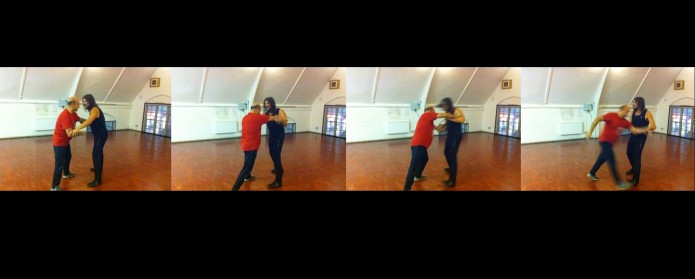This series of photographs shows Chris (red) initiating right and left pushes with the intent of unbalancing his opponent.
Dave (black), listening for changes in his opponent’s movement detects Chris’s intent, absorbing the right push with a solidly structured stance and redirecting the left push using softness and flexibility, guiding Chris’s force into “the void” (i.e. unbalancing the attacker).
Principles of Yin and Yang
External use of yin yang –
In the martial art of taijiquan, the principles of yin and yang are followed. Attacking follows yang characteristics, defending follows yin. A taiji player aims to counter an attacker’s yang by using yin to absorb and defuse the attack. The yang force is not met head on and blocked, yang is not used against yang. Instead the defender moves aside of the attack or diffuses it by absorbing it, this follows yin characteristics. Once an attacker’s yang has been nullified, he or she is vulnerable and often unbalanced, becoming yin, and yang can then be used in a counter-attack.
Educated force, jin, force with technique, stemming from an understanding of yin and yang, is essential to taiji. The ability to switch between effective yin and yang quickly requires suppleness, agility and responsive speed and power.
The Taiji hand form consists of a series of movements in which yin and yang interchange. It develops awareness of the way yin and yang can be used in self-defence and of the way your body works naturally.
Drilling applications and pushing hands styles in class develops your practical and actual physical understanding of yin yang theory and not just an intellectual understanding.
Internal use of yin and yang –
Natural body movements and mechanics also reflect yin yang theory and an internal awareness of this in your training develops a natural physical and mental compose. Muscles work in antagonistic pairs, one contracts the other lengthens, yin and yang. An excess of yang produces unwanted tension and will constrict, slow, weaken and desensitise your movements. Too much stress in your mind is too much yang and a clam responsive awareness is yin, so the mind needs a balance of yin and yang as well.
Taiji is yin and yang in harmony.
Some ancient European symbols of similar appearance –

Ornamental Bronze Plaque, Celtic Horse-gear, Santon, Norfolk

Shield pattern of the Western Roman infantry unit Armigeri Defensores Seniores(c. AD 430)
